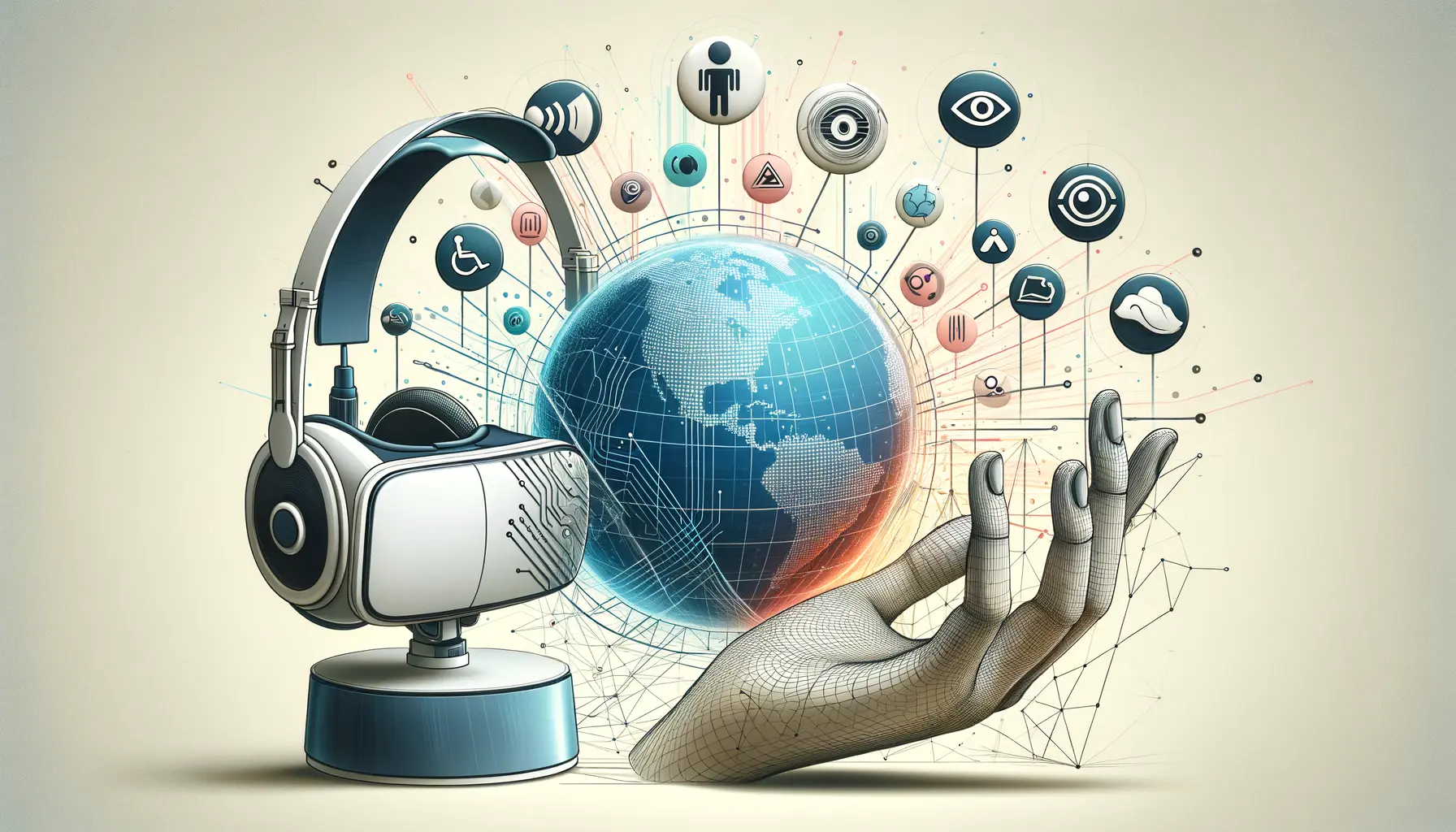Web accessibility has become a cornerstone of digital inclusivity, ensuring that everyone, regardless of their physical abilities, can access and benefit from the vast resources available online.
Among the technologies driving this inclusivity, voice recognition stands out as a transformative tool.
It bridges the gap for users with visual impairments, mobility issues, and other disabilities that make traditional navigation and interaction methods challenging.
By enabling voice commands to control websites and applications, this technology fosters an environment where digital content is more accessible to all.
The integration of voice recognition into web accessibility not only aligns with the principles of the Web Content Accessibility Guidelines (WCAG) but also represents a leap towards fulfilling the promise of the internet as a universally accessible platform.
As we delve deeper into the nuances of this technology, it’s clear that its impact extends beyond convenience, offering a lifeline to users who might otherwise be excluded from the digital dialogue.
This exploration aims to shed light on how voice recognition technology is reshaping the landscape of web accessibility, making it more inclusive and user-friendly.
- The Evolution of Voice Recognition in Accessibility
- Key Technologies Behind Voice Recognition
- Implementing Voice Recognition for Web Accessibility
- Challenges and Solutions in Voice Recognition
- Impact of Voice Recognition on User Experience
- Future Directions of Voice Recognition in Accessibility
- Global Impact and Adoption of Voice Recognition
- Conclusion: The Transformative Power of Voice Recognition in Web Accessibility
- FAQs on Voice Recognition Technology and Web Accessibility
The Evolution of Voice Recognition in Accessibility
From Novelty to Necessity
The journey of voice recognition technology from a futuristic novelty to a critical component of web accessibility underscores its growing importance.
Initially developed as an aid for executing simple commands on computers and mobile devices, voice recognition has evolved into a sophisticated tool that enhances the web browsing experience for individuals with disabilities.
This evolution has been propelled by significant advancements in artificial intelligence (AI) and machine learning, enabling more accurate and responsive voice-activated systems.
Today, voice recognition technology is embedded in various devices and platforms, from smartphones and smart speakers to web browsers and applications.
Its integration into the digital ecosystem has made it an indispensable tool for users who rely on voice commands to interact with online content.
The technology’s ability to understand and process natural language has improved remarkably, allowing for more complex interactions and commands.
This progress has opened up new possibilities for web accessibility, making it easier for users with disabilities to navigate, consume, and engage with digital content.
Breaking Down Barriers
Voice recognition technology has played a pivotal role in breaking down the barriers that have traditionally hindered web accessibility.
By enabling voice-based navigation and control, it allows users with physical disabilities to perform tasks that would otherwise require manual input, such as typing or mouse clicks.
This capability is particularly beneficial for individuals with limited mobility or dexterity, for whom traditional input methods are not feasible.
Moreover, voice recognition extends its benefits to users with visual impairments.
By converting voice commands into actions, it enables these users to browse the internet, fill out forms, and even interact with multimedia content without the need for visual cues.
This level of accessibility is transformative, offering a degree of independence and engagement that was previously difficult to achieve.
The technology’s adaptability to various languages and accents further enhances its inclusivity, making the web a more accessible space for a diverse global audience.
Voice recognition technology is not just an accessibility feature; it’s a gateway to digital inclusivity, enabling users with disabilities to navigate the web with ease and confidence.
Key Technologies Behind Voice Recognition
The effectiveness of voice recognition technology in enhancing web accessibility is underpinned by several key technologies.
These foundational elements work in tandem to process, understand, and execute voice commands, making digital content more accessible to users with disabilities.
Understanding these technologies provides insight into how voice recognition systems are able to offer such a seamless interaction experience.
Artificial Intelligence and Machine Learning
At the heart of voice recognition technology lies artificial intelligence (AI) and machine learning.
These technologies enable systems to learn from vast amounts of voice data, improving their ability to recognize speech patterns, accents, and languages over time.
Machine learning algorithms analyze the characteristics of human speech, including tone, pitch, and speed, to accurately interpret and respond to user commands.
Natural Language Processing
Natural Language Processing (NLP) is another critical technology that allows voice recognition systems to understand and process human language.
NLP bridges the gap between human communication and computer understanding, enabling systems to comprehend commands given in natural, conversational language.
This capability is crucial for making web content accessible through voice commands, as it allows users to interact with websites and applications as if they were speaking to another person.
Speech-to-Text Conversion
Speech-to-text (STT) conversion technology translates spoken words into written text.
This process is essential for voice recognition systems, as it converts voice commands into a format that can be processed by computers.
STT technology has advanced significantly, with current systems capable of recognizing speech with high levels of accuracy, even in noisy environments or when the speaker has an accent.
- Audio Signal Processing: This involves capturing and digitizing audio signals from the user’s speech. It includes noise reduction and echo cancellation to ensure clear voice input.
- Pattern Recognition: The system compares the processed audio signals against a database of speech patterns to identify words and phrases.
- Contextual Understanding: Beyond recognizing individual words, the system uses context to interpret the meaning of sentences, improving the accuracy of responses.
Together, these technologies form the backbone of voice recognition systems, enabling them to provide an accessible web experience for users with disabilities.
By leveraging AI, machine learning, NLP, and STT, voice recognition technology has become a powerful tool for web accessibility, allowing users to navigate, interact, and engage with content in ways that were previously unimaginable.
The synergy between AI, machine learning, NLP, and STT technologies is what makes voice recognition an effective solution for web accessibility challenges.
Implementing Voice Recognition for Web Accessibility
Integrating voice recognition technology into web design and development is a critical step towards creating accessible digital environments.
This process involves several key considerations and best practices to ensure that websites and applications are fully navigable and usable through voice commands.
By prioritizing voice recognition in web accessibility strategies, developers can significantly enhance the user experience for individuals with disabilities.
Designing for Voice Interaction
Designing for voice interaction requires a shift in perspective from traditional web design principles.
It involves understanding how users with disabilities might use voice commands to interact with web content and structuring the website accordingly.
This includes creating clear, concise, and navigable content that can be easily interpreted by voice recognition systems.
Additionally, providing alternative text for images and ensuring that all interactive elements are voice-command accessible are crucial steps in this process.
Developing Voice-Enabled Features
Developing voice-enabled features involves incorporating backend technologies that can process and respond to voice commands.
This includes integrating speech-to-text APIs, developing custom voice command libraries for specific actions, and ensuring that the website’s architecture supports voice navigation.
Developers must also consider the security and privacy implications of processing voice data, implementing robust data protection measures to safeguard user information.
- Ensuring compatibility with screen readers and voice recognition software.
- Providing voice command options for all clickable elements, forms, and navigation links.
- Implementing voice feedback for actions taken by users, enhancing the interactive experience.
Testing and Optimization
Testing and optimization are critical to the successful implementation of voice recognition for web accessibility.
This involves conducting thorough testing with users who rely on voice commands to navigate the web, identifying any barriers or challenges they encounter.
Feedback from these testing sessions can then be used to refine and optimize the voice interaction experience.
Additionally, ongoing monitoring and updating are necessary to adapt to advancements in voice recognition technology and evolving user needs.
Incorporating voice recognition into web accessibility efforts not only benefits users with disabilities but also enhances the overall user experience, making digital content more interactive and accessible to a wider audience.
Challenges and Solutions in Voice Recognition
The integration of voice recognition technology into web accessibility initiatives presents unique challenges.
These obstacles range from technical limitations to user-specific issues, such as varying speech patterns and accents.
Addressing these challenges is crucial for creating a truly inclusive web environment that accommodates all users, regardless of their abilities or disabilities.
One of the primary challenges is the technology’s ability to accurately recognize and process diverse speech patterns.
Users with disabilities, particularly those affecting speech, may find that voice recognition systems struggle to understand their commands.
This issue is compounded by regional accents and dialects, which can further hinder the system’s accuracy.
However, solutions are emerging as technology advances.
Continuous improvements in AI and machine learning algorithms are enhancing the systems’ ability to learn from a broader range of speech samples, thereby improving accuracy and inclusivity.
Enhancing System Training with Diverse Data Sets
To overcome the challenge of speech diversity, developers are focusing on training voice recognition systems with more diverse data sets.
By including speech samples from individuals with various speech patterns, accents, and disabilities, the technology can become more adept at understanding a wider array of users.
This approach requires collaboration with communities and individuals willing to contribute their voices to the cause, enriching the system’s training data and making it more representative of the global population.
Privacy and Security Concerns
Another significant challenge is ensuring the privacy and security of voice data.
As voice recognition systems require access to sensitive audio inputs, safeguarding this information from unauthorized access is paramount.
Solutions include implementing stringent data encryption, secure transmission protocols, and clear user consent mechanisms.
Additionally, developers must adhere to privacy regulations and standards, ensuring that users’ data is protected throughout the voice recognition process.
- Adopting transparent data collection and processing policies.
- Providing users with control over their voice data, including the ability to review, delete, or opt-out of data collection.
- Regularly updating security measures to combat emerging threats and vulnerabilities.
Despite these challenges, the potential of voice recognition technology to enhance web accessibility is undeniable.
By addressing these issues head-on, developers can unlock the full potential of voice recognition, creating a web that is more accessible, inclusive, and secure for all users.
True inclusivity in web accessibility through voice recognition technology requires not only technological advancements but also a commitment to privacy, security, and the diverse needs of users worldwide.
Impact of Voice Recognition on User Experience
The advent of voice recognition technology has significantly transformed the user experience, especially for individuals with disabilities.
This technology has not only made the web more accessible but also enriched the interaction between users and digital content.
The impact of voice recognition on user experience is profound, offering a more intuitive, efficient, and inclusive way to navigate the digital world.
Enhancing Accessibility and Independence
For users with visual impairments or physical disabilities, voice recognition technology provides an essential tool for accessing information and services online.
It enables these users to perform web searches, access news, shop online, and use social media without the need for traditional input methods like keyboards or mice.
This level of accessibility fosters greater independence, allowing users to explore the web freely and engage with content on their own terms.
Moreover, voice recognition technology empowers users with disabilities by giving them control over their digital environment.
They can customize their experience, from adjusting settings to navigating websites, using simple voice commands.
This empowerment enhances their confidence in using technology, contributing to a more positive and fulfilling online experience.
Streamlining Interactions and Transactions
Voice recognition technology also streamlines interactions and transactions on the web, making them more efficient and user-friendly.
Users can complete forms, make purchases, and access services with ease, significantly reducing the time and effort required for these activities.
This efficiency is particularly beneficial for users with cognitive disabilities, who may find complex navigation and lengthy processes challenging.
The technology’s ability to understand and execute complex commands further enhances the user experience.
Users can perform multiple actions through a single voice command, from opening websites to controlling smart home devices.
This seamless integration of voice recognition into daily activities and web interactions underscores its transformative impact on the user experience.
- Improving the accuracy and responsiveness of voice recognition systems to better understand diverse speech patterns.
- Expanding the integration of voice recognition technology across different platforms and devices, ensuring a consistent and accessible user experience.
- Continuing to prioritize privacy and security in the development and implementation of voice recognition features.
The impact of voice recognition on the user experience is a testament to the technology’s potential to create a more accessible, efficient, and inclusive digital world.
As voice recognition technology continues to evolve, its role in enhancing web accessibility and enriching the user experience will undoubtedly grow, benefiting users across the spectrum of abilities.
Voice recognition technology is reshaping the user experience, offering a gateway to a more accessible, efficient, and inclusive digital world for users with disabilities.
Future Directions of Voice Recognition in Accessibility
The landscape of voice recognition technology is continuously evolving, driven by advancements in artificial intelligence, machine learning, and natural language processing.
As these technologies advance, the potential for voice recognition to enhance web accessibility grows exponentially.
Looking towards the future, several key directions are emerging that promise to further integrate voice recognition into the fabric of web accessibility, making the digital world more inclusive for all users.
Advancements in AI and Machine Learning
Future advancements in AI and machine learning are set to significantly improve the accuracy and efficiency of voice recognition systems.
These technologies will enable systems to better understand context, nuance, and even emotions in speech, making interactions more natural and intuitive.
As voice recognition systems become more sophisticated, they will be able to accommodate a wider range of speech patterns, dialects, and accents, thereby enhancing accessibility for a global audience.
Moreover, AI and machine learning will facilitate the development of personalized voice recognition systems.
These systems will adapt to individual users’ speech patterns and preferences, providing a customized web navigation experience.
This personalization will be particularly beneficial for users with unique speech characteristics, ensuring that voice recognition technology meets their specific needs.
Integration Across Devices and Platforms
The integration of voice recognition technology across a broader range of devices and platforms is another key direction for the future.
This expansion will ensure that users can access voice-enabled web content not only on their computers and smartphones but also on smart home devices, wearables, and even in vehicles.
Such widespread integration will provide users with disabilities more opportunities to interact with digital content in various contexts and environments, enhancing their overall web accessibility.
As voice recognition becomes a standard feature across devices, developers and designers will need to adopt a voice-first approach to web accessibility.
This approach will prioritize voice interaction in the design and development process, ensuring that websites and applications are optimized for voice navigation from the outset.
- Collaboration with disability communities to ensure voice recognition technology meets their needs and preferences.
- Continued emphasis on privacy and security, particularly as voice recognition systems become more integrated into our daily lives.
- Exploration of new applications for voice recognition technology, such as virtual reality and augmented reality, to create more immersive and accessible web experiences.
The future of voice recognition in web accessibility is bright, with ongoing advancements poised to make the digital world more accessible and inclusive.
By embracing these future directions, developers, designers, and technology providers can ensure that voice recognition continues to play a pivotal role in breaking down barriers and empowering users with disabilities.
The evolution of voice recognition technology holds the promise of a more inclusive digital future, where web accessibility is enhanced for users of all abilities.
Global Impact and Adoption of Voice Recognition
The global impact and adoption of voice recognition technology in web accessibility are profound, marking a significant shift in how users interact with digital content.
As this technology becomes more widespread, its role in promoting digital inclusivity on a global scale becomes increasingly evident.
The adoption of voice recognition across different regions and languages highlights its potential to create a universally accessible web, transcending geographical and linguistic barriers.
Breaking Linguistic Barriers
Voice recognition technology’s ability to support multiple languages and dialects is instrumental in breaking down linguistic barriers online.
By providing support for a wide range of languages, voice recognition enables users from diverse linguistic backgrounds to access and interact with web content in their native language.
This inclusivity is crucial for global web accessibility, ensuring that users worldwide can benefit from the digital revolution, regardless of their language.
Furthermore, the ongoing development of voice recognition technology aims to improve its understanding of regional accents and dialects, making digital content more accessible to users in different parts of the world.
This global approach to web accessibility fosters a more inclusive digital environment, where users can navigate the web seamlessly in their preferred language.
Empowering Diverse Communities
The adoption of voice recognition technology has the potential to empower diverse communities, particularly those with disabilities, by providing them with equal access to information, services, and opportunities online.
For individuals with visual impairments, mobility issues, or speech impairments, voice recognition offers an alternative way to interact with the web, enhancing their independence and participation in the digital world.
As voice recognition technology becomes more integrated into web design and development, its impact on diverse communities will continue to grow.
By prioritizing accessibility and inclusivity, developers and designers can ensure that digital content is accessible to everyone, regardless of their abilities or disabilities.
- Expanding voice recognition support to include more languages and dialects, further enhancing global web accessibility.
- Encouraging the development of voice-enabled applications and services that cater to the needs of diverse communities.
- Advocating for policies and standards that promote the integration of voice recognition technology into web accessibility initiatives worldwide.
The global impact and adoption of voice recognition technology underscore its significance in creating a more accessible and inclusive digital world.
As this technology continues to evolve and expand, its potential to transform web accessibility on a global scale is limitless.
By embracing voice recognition, we can move closer to a future where the web is accessible to all, regardless of language, location, or ability.
It’s a misconception that voice recognition technology benefits only users with disabilities. In reality, its global impact and adoption enhance web accessibility and user experience for everyone, making the digital world more inclusive and accessible.
Conclusion: The Transformative Power of Voice Recognition in Web Accessibility
The journey through the realms of voice recognition technology and its impact on web accessibility reveals a transformative power that extends beyond mere convenience.
This technology has emerged as a pivotal force in the quest for digital inclusivity, breaking down barriers that have long excluded individuals with disabilities from fully participating in the digital world.
As we have explored, the integration of voice recognition into web accessibility initiatives is not just about adhering to guidelines or meeting compliance standards; it’s about reshaping the digital landscape to be more inclusive, intuitive, and user-friendly for everyone.
Envisioning an Inclusive Digital Future
The future of voice recognition technology in web accessibility is bright, filled with potential for further innovation and integration.
As AI and machine learning continue to evolve, we can anticipate even more sophisticated voice recognition systems that understand and process human speech with unprecedented accuracy and nuance.
The implications for web accessibility are profound, promising a digital environment where everyone, regardless of their physical abilities or linguistic background, can navigate, interact, and contribute with ease.
Key Takeaways for a More Accessible Web
- Continuous improvement in AI and machine learning algorithms will enhance the accuracy and adaptability of voice recognition systems, making them more inclusive of diverse speech patterns and accents.
- Expanding the integration of voice recognition across devices and platforms ensures a seamless and consistent user experience, further democratizing access to digital content.
- Collaboration between technology developers, designers, and disability communities is crucial for tailoring voice recognition technologies to meet the varied needs of users with disabilities.
- Privacy and security remain paramount, as the adoption of voice recognition technology involves the processing of sensitive personal data. Ongoing efforts to safeguard user information will build trust and encourage wider acceptance of this technology.
In conclusion, voice recognition technology stands as a beacon of progress in the ongoing effort to make the web accessible to all.
Its role in enhancing web accessibility underscores the importance of embracing innovative solutions to address the diverse needs of the global online community.
As we look to the future, the continued development and adoption of voice recognition technology will undoubtedly play a critical role in creating a more inclusive, accessible, and equitable digital world.
Quality web design is key for a great website! Check out our service page to partner with an expert web design agency.
FAQs on Voice Recognition Technology and Web Accessibility
Explore common questions about how voice recognition technology enhances web accessibility, providing insights into its impact, functionality, and future directions.
Voice recognition technology allows users to interact with web content through spoken commands, enhancing accessibility for those with disabilities.
It enables users with visual, physical, and cognitive impairments to navigate and control websites using voice commands, making the web more accessible.
Integrating voice recognition improves website usability, accessibility, and provides a hands-free interaction option for all users.
Yes, modern systems are increasingly adept at recognizing and processing a wide range of accents, enhancing inclusivity and accessibility.
Yes, but developers implement stringent security measures to protect voice data and ensure user privacy and consent are prioritized.
By designing voice-navigable interfaces, using semantic HTML, and ensuring compatibility with voice recognition software and assistive technologies.
Future advancements include improved accuracy, understanding of context and nuance, and personalized user experiences through AI and machine learning.
It breaks down linguistic and physical barriers, making digital content more accessible and navigable for users worldwide.














